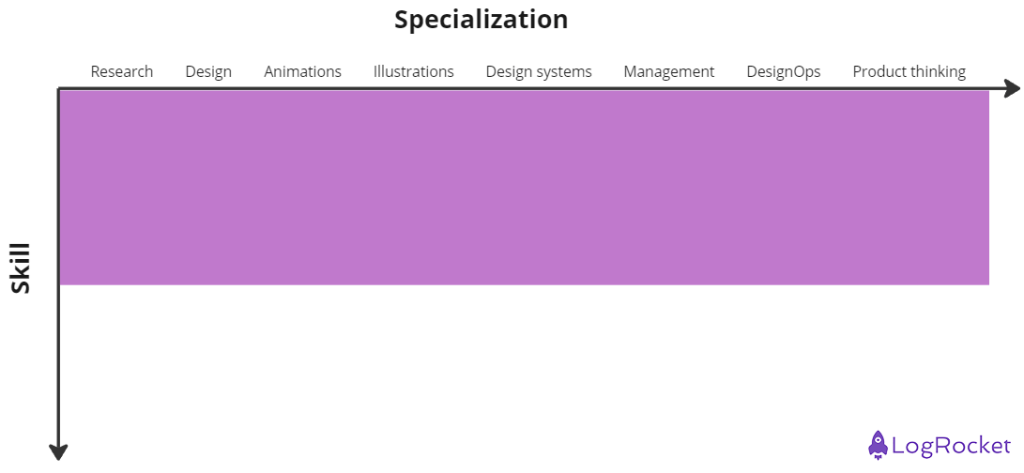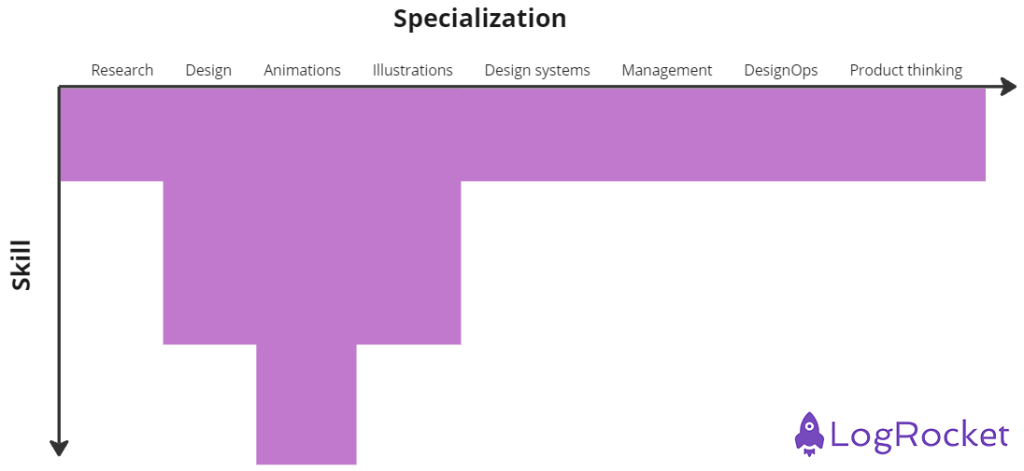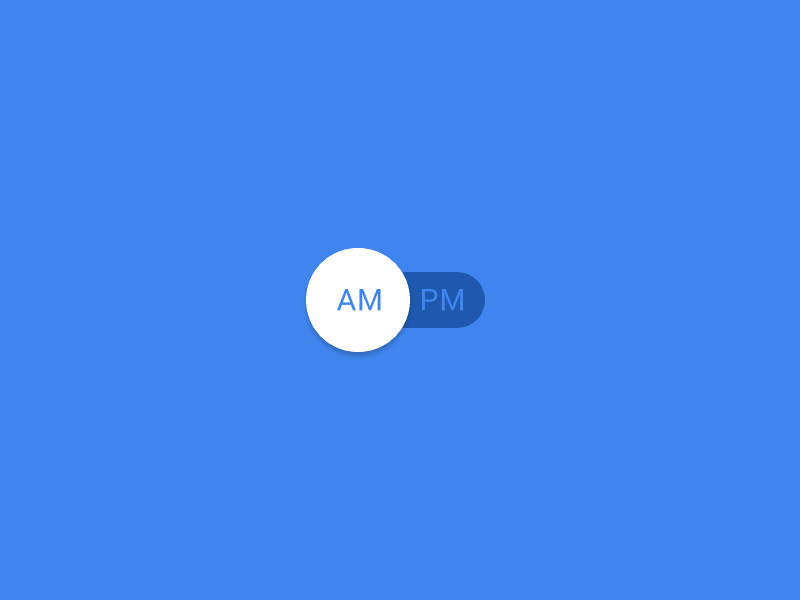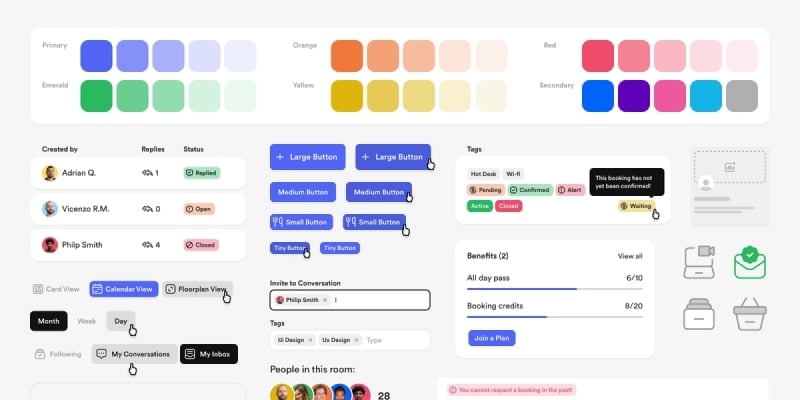
UX design is a broad field of expertise. It includes user research, wireframing, prototyping, and preparing perfect micro-interactions.
Given the vastness of UX design, it’s impractical to master all its areas. This is where UX specializations come in. While there’s nothing wrong with being a UX generalist, there are distinct benefits to becoming a specialist in a particular area.
Let’s explore the topic of UX design specializations further. Who knows, maybe you’ll even fall in love with one!
Let’s start by briefly covering the difference between UX specialists and generalists.
By definition, a UX generalist is a team of one and a jack of all trades. They are roughly equally skilled in all crucial areas of UX design but may sometimes lack in one or two specific areas:

Conversely, UX specialists tend to be highly skilled in one or two areas and often have only a fundamental knowledge of other areas:

Even if you were a skilled generalist before, as you specialize, you tend to practice other skills less often, and they naturally depreciate over time.
Today, there’s a high demand for UX generalists in startups and small companies that can’t afford big design departments. UX specialists are often more desired by bigger corporations.
Should you be a specialist or a generalist?
Ultimately, the choice between being a specialist or a generalist is yours. If you find an area of design you truly love, go all in, take up UX design courses, and become an expert. But, if you love a bit of everything, generalization is a perfectly valid and rewarding career path.
This list could easily consist of a hundred possible specializations and sub-specializations, each offering a unique and exciting career path. Could you have imagined some companies have dedicated icon designers?
However, I have listed the most common and high-level specializations to make the list manageable and navigable. This list should cover 90% of real-life scenarios.
Keep in mind that the exact name and specific job responsibilities might differ from company to company. So, treat this list as a guide and always double-check specific job descriptions for roles you apply for:
UX researchers are masters of… well… research.
I often call them insight factories — they combine qualitative and quantitative UX research methods to produce user insights that inform design and product decisions.
Interacting with users and performing various forms of behavioral analysis is the bread and butter of UX researchers.
Deliverable of a UX researcher:
User insights
Day-to-day tasks:
Most important skills:
Who is this specialization for:
UX research is a perfect place for curious individuals who want to learn more about why people behave a certain way. It’s also an ideal specialization for true extroverts. But if human interactions drain you, this role might not fit you best.
People specializing in UI design master turning complex problems into simple, intuitive, beautiful screens and prototypes. They do most of the design work, occasionally leaving polishing work to motion designers and illustrators.
Deliverable of a UI designer:
High-fidelity design
Common day-to-day tasks:
Most important skills:
Who is this specialization for:
If you enjoy solving logical puzzles, a UI design role might be great for you. Interaction designers are problem-solvers — they often need to combine complex business and user needs and solve them in as simple an interface as possible, which usually requires numerous iterations to get right.
An illustrator adds character to designs by creating custom illustrations on screens. They add uniqueness to the design so the rest of the design team can match the illustration perfectly to the message the page should communicate — something often impossible if you use pictures or free illustrations from the Internet.
Deliverable of an illustrator:
Static illustrations
Common day-to-day tasks:
Most important skills:
Who is this specialization for:
If you find yourself highly creative and artistic and enjoy visual storytelling, you might find yourself succeeding as an illustrator.
Motion designers breathe life into illustrations and user interfaces by designing animations and micro-animations. They ensure that everything that moves is executed perfectly. Great animations are often what make particular products memorable:

Deliverable of a motion designer:
Animated assets
Common day-to-day tasks:
Most important skills:
Who is this specialization for:
There are two types of designers — those who find animation and motion design excessively time-consuming and those who love improving the timing of their animations to the millisecond to make them beautiful. You just need to try out and discover which one you are. If you’re the latter sort of designer, motion design is your role.
UX writers specialize in creating a user experience via copy. This often includes both long-form copy (for example, product descriptions), short-form copy (for example, headlines), and micro-copy (for example, button labels). So, a UX writer ensures that the copy is crystal clear and helps users move through the user journey.
Deliverable of a UX writer:
Copy
Common day-to-day tasks:
Most important skills:
Who is this specialization for:
Some people simply excel at explaining complex concepts easily. If you are great at those ‘explain me like I’m five years old’ challenges, you might enjoy the UX writing path. But remember that specializing in UX writing requires quite a lot of research work.
Some design projects require the input of multiple UX specialists, which would require a dedicated person to coordinate and manage all design work — that’s a UX lead.
You could think of a UX lead as a project manager of a UX initiative. They ensure the project doesn’t fall apart when uncoordinated people try to work together without a structure.
Deliverable of a UX lead:
Design project
Common day-to-day tasks:
Most important skills:
Who is this specialization for:
This is your role if you love organizing people and processes while remaining close to the action and product itself. UX leads are great leaders who either hate the politics and paperwork of managerial roles or don’t want to give up their input as individual contributors.
A UX manager has two crucial jobs: ensuring the team is well-performing and motivated and building company-wide processes and culture to help designers do their jobs well. But this UX design specialization comes with a healthy dose of paperwork and company politics to deal with.
Deliverable of a UX manager:
Team performance and morale
Common day-to-day tasks:
Most important skills:
Who is this specialization for:
Some people just have this leadership knack. If you get a lot of gratification from helping others grow, prefer to work on a higher level, and don’t mind occasional paperwork related to managerial positions, UX management might be a good fit.
Design system specialists create order. They ensure consistency and scalability by developing and documenting design components in a centralized repository, making the work of other designers significantly easier.
Ever used a drag-and-drop website builder? If yes, that’s how designers often feel when working with a well-maintained design system:

Deliverable of a design system specialist:
Design system
Common day-to-day tasks:
Most important skills:
Who is this specialization for:
If you love structure, clarity, and order, look no further. Design system specializations are a great path for designers who discover they don’t strive in ambiguous environments or lack creativity. Working on design systems is a great way to put your UI skills into something structured, predictable, and organized.
Although product management is a different career track, many UX designers come from UX design backgrounds — after all, these roles are not so far apart.
Product managers combine user insights and business objectives to build a product roadmap and strategy that helps users and businesses achieve their goals. This is a common path for UX designers who want to go beyond “just UX.”
Deliverable of a product manager:
Product strategy
Common day-to-day tasks:
Most important skills:
Who is this specialization for:
Becoming a product manager in design is for visionaries who love a high dose of ownership — with all its perks and cons — and are interested in the internal workings of a business and might pivot to product management, which is an exciting career alternative.
If, after reading this list, you fell in love with one or two specialties, that’s great!
Do further research, work on skills you lack, and plan your career path accordingly.
But if you didn’t, don’t worry.
What you need to do is to become more conscious in your day-to-day work. Observe what tasks give you the most joy and fulfillment, which ones drain you, and which ones you excel at. Over time, you’ll discover which UX design specializations are most suitable for you.
And if you fancy doing a bit of everything, there’ll always be room for UX generalists, especially in startups!
LogRocket's Galileo AI watches sessions and understands user feedback for you, automating the most time-intensive parts of your job and giving you more time to focus on great design.
See how design choices, interactions, and issues affect your users — get a demo of LogRocket today.

Small actions can have large consequences in complex systems. Here’s how UX designers can manage dependencies so users feel informed and in control rather than blocked or blindsided.

This article examines when hero sections are necessary in digital products, when they create friction, and how to evaluate them using UX goals, primary actions, user flow impact, and real-world alternatives.

AI speeds up tasks like research synthesis, ideation, and first-draft wireframes, but it can’t replace clarity, taste, or decision-making. Here’s a grounded look at what AI actually does well in UX right now.

Discover how to craft UX-friendly hero sections with examples, design tips, and strategies that drive engagement and conversion.